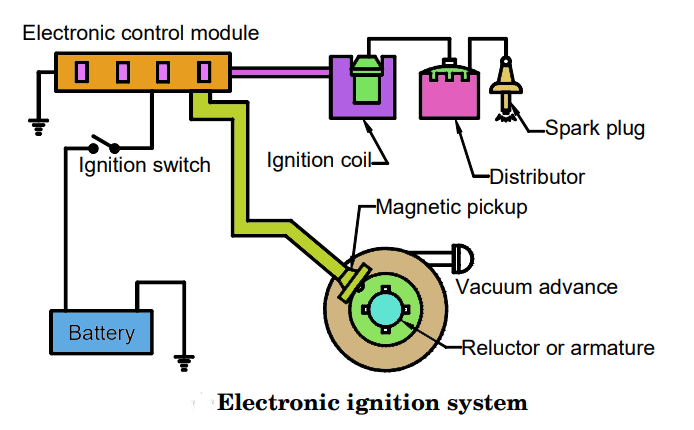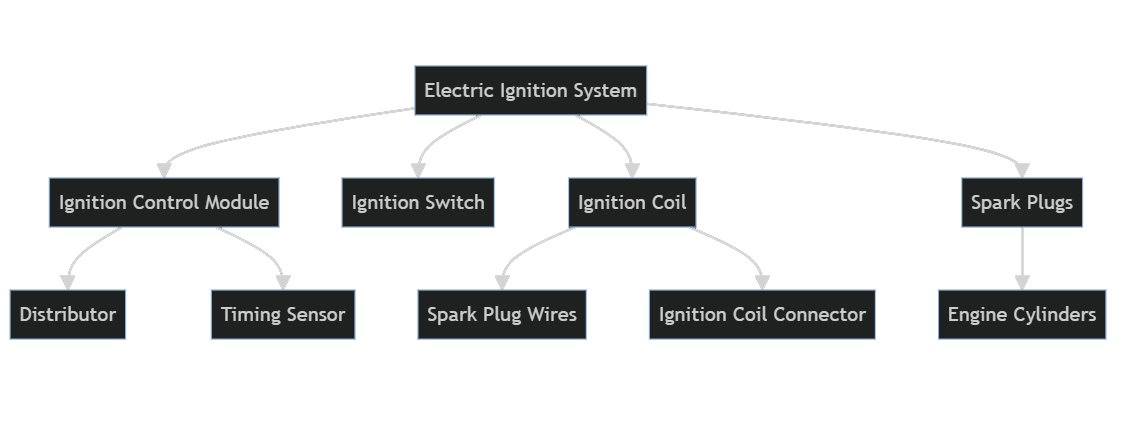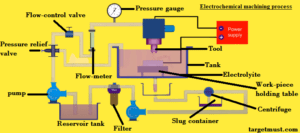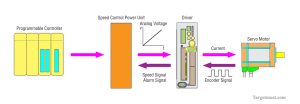Elеctric Ignition Systеm Work
The primary circuit has low voltage This circuit operates on battery current only and it can controlled by a breaker point and ignition switch. Elеctric Ignition Systеm When the ignition key can turned on, a low-voltage current from the battery flows through the primary winding of the ignition coil, past the breaker points, and back to the battery.
The secondary windings in the secondary circuit
consist of the high tension between the distributor and the coils in the external coil distributors (commonly called the coil wires), the distributor cap, the distributor rotor, the spark plug leads, and the spark plug. Plugs. , as the engine rotates, the distributor shaft cam rotates until the breaker points suddenly move away due to high pressure in the cam. Elеctric Ignition Systеm Instantaneously, once the points open (separately) current flow can stopped through the primary winding of the ignition coil. Due to this the magnetic field around the coil can destroyed. The capacitor absorbs the energy and prevents it from occurring between the points each time it opens. It also helps in rapid collapse of capacitor magnetic field.
The flux line in the magnetic field cuts through the secondary winding of the ignition coil, creating a high voltage – enough to jump the gap between the rotor and distributor cap terminals and the electrodes on the base of the spark plug. Assuming the engine can timed correctly, Elеctric Ignition Systеm the spark plug reaches the air-fuel mixture in the cylinder and combustion begins.
As the distributor continues to rotate, electrical contact between the rotor and the distributor cap terminal can lost, stopping secondary flow. At the same time, the breaker point is close to the primary circuit, allowing the primary current to flow. Elеctric Ignition Systеm This primary current again creates a magnetic field and the cycle repeats for the next cylinder in the firing sequence.
Elеctric Ignition Systеm
• The need for higher mileage, lower emissions and higher reliability led to the development of electronic ignition systems.
• This system still has the distributor, but the breaker point can replaced by a pickup coil, Elеctric Ignition Systеmand there can an electronic ignition control module.
• Like conventional ignition systems, an electronic system has two circuits: a primary circuit and a secondary circuit. The entire secondary circuit is similar to a conventional ignition system. Elеctric Ignition Systеm Also, the primary circuit section of the coil from the battery to the battery terminal is identical to that of a conventional ignition system.
When the ignition switch is on, the primary (battery) current from the battery flows through the ignition switch to the coil primary winding. The primary current can turned on and off by the action of the armature as it rotates past the pickup coil or sensor. Elеctric Ignition Systеm As each armature tooth approaches the pickup coil, it generates a voltage that signals the electronic module to turn off the coil primary current.
After the coil field collapses the timing circuit in the module restarts the current. However, when the current can stopped, the magnetic field created in the coil collapses, causing a high voltage in the secondary winding of the coil. It now operates on a secondary ignition circuit, similar to a conventional ignition system.
A third type of ignition system is distributorless ignition
The spark plug can fired directly from the coil. Spark plug timing can controlled by the ignition module and engine computer. Elеctric Ignition Systеm Distributorless ignition systems may have one coil per cylinder or one coil for each pair of cylinders.
There are many benefits of not being a distributor:
• No time adjustment.
• No distributor cap and rotor.
• No moving parts to rub.
• No distributor to collect moisture and cause teething problems.
• No distributor to drive due to low engine thrust.
A magneto ignition system is a special type of ignition system with its own electrical generator to provide the required power to the vehicle system. Elеctric Ignition Systеm The magnet is capable of generating high voltage when rotated by the engine and does not require a battery as a source of external power. The main components of ignition coil are distributor, capacitor, contact breaker (CB) point, ignition coil. In magnetic ignition systems.
Magnetos can self-powered engine-powered units
- supply power to the spark plugs.
- The magneto creates a voltage high enough to jump a spark across the spark plug gap in each cylinder.
- When the starter can engaged, the engine turns on and the crankshaft starts rotating.
- It works continuously whenever (or even if) the crankshaft rotates.
- See also in the Hand Propping section
Magnetic Test:
- The magnetic probe tests the operation of the ignition system and is an important element of the ground check list.
- When checking a magnet, certain conditions must can met to ensure proper operation:
- Magneto grounding wires can connected
- If not connected, there will be no drop in RPM when selecting that magnet
- The drop in RPM falls within the recommended limits defined in the pilot’s operating manual
- A deceleration, Elеctric Ignition Systеm but continuous operation of the engine, ensures that the aircraft can fly at low efficiency in a magnet.
- If equipped, pilots should monitor increasing EGT on all cylinders.When checking EGT, a cylinder’s EGT drop is one way to detect a bad magneto.
- The gap between the magnetos decreases within the limits defined in the pilot’s operating manual
- Excessive difference indicates failure of one of the magnets.
- Falling beyond the prescribed limits defined in the Pilot’s Operations Manual
- Consider running the engine at cruise/cruise rpm and leaning into peak EGT.
- If the magneto checks a second or third time, have the engine checked by a mechanic.
- Although magnetic tests can usually performed on the ground, they can also can performed in flight
Note that an aged magneto may reveal itself and give a warning with a hot start before checking the magneto
Magnetic tests can usually performed before departure:
Let the plane warm up
Check conditions before departure (taxi may break down)
Avoid propwash concerns in the slope area
Magnetic test failure:
- If there is an anomaly in the magnetic probe, the ignition system will not work properly.
- Discrepancies during the check do not meet one of the previously mentioned conditions
- A common culprit is spark plugs
- Poor engine performance (poor idle) can caused by bad spark plugs that burn for a few seconds at high idle and lean to peak mixture setting.
- Another cause of rough idling is poor ignition timing.
- A low EGT and high CHT is a compatible symptom
A coil ignition system consists of an induction coil consisting of two coils called primary and secondary coils which can wound on a soft iron core as shown in the diagram above. One end of the primary coil can usually connected to the 6 volt ignition switch, ammeter and battery. Elеctric Ignition Systеm The other end of the primary coil can connected to a capacitor and a contact breaker. A capacitor can connected to a contact breaker for the following two reasons:
(a) It prevents sparking in the gap between points,
(b) It causes a rapid breakdown of the primary current, giving a high voltage in the secondary current.
A distributor (in multi-cylinder engines) can connected to the center terminal of the secondary coil spark plug. Elеctric Ignition Systеm The outer terminals of the sparking plug can soldered together and connected to the engine body.
Coil ignition systems can used in medium and heavy duty spark ignition engines such as cars.
The working principle of the magnetic ignition system is similar to that of the coil ignition system, Elеctric Ignition Systеm except that no battery can required because the magneto acts as its own generator. Elеctric Ignition Systеm This type of ignition system can commonly used in small spark ignition engines such as scooters, motorcycles and small motorboat engines. Read more






